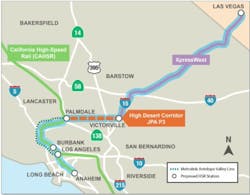HSR Investment-Grade Study Shows Promising Numbers for Future Revenue and Ridership
The High Desert Corridor (HDC) is one of 16 highway projects that has been identified under the 30/10 Initiative for acceleration. The Los Angeles Metropolitan Transit Authority (Metro) has partnered with Caltrans, the High Desert Corridor Joint Powers Authority and other agencies to expedite this project. The first leg of the project is a 185-mile rail line that runs from Las Vegas to Victorville, California. The rail line would extend 50 miles past Victorville to the current commuter rail line in Palmdale.
On March 2, the High Desert Corridor Joint Powers Authority announced in a webinar the results from the Investment Grade Ridership and Revenue Study for the High Desert Corridor (HDC) high-speed rail line which would provide a link between California and Nevada.
Consultant Neil Peterson explained that the purpose of the webinar was to examine the entire corridor to determine what potential ridership and what revenue would look like for the HSR line. "Currently Interstate 15 is the only way to get to Vegas from California. This is a heavily used route that is subjected to delays. With high-speed rail, the connection could occur in two and a half hours."
Peterson added that aside from the benefits to travel time, the HSR line would have a significant impact on predictability and safety. "We have a very important project here for safety and congestion relief. We have a high level of interest from all levels of government … we expect the private sector to be very interested in these numbers."
The plan is to create the HSR line as a public-private partnership (P3), the line would be beneficial to both states.
"When you bring two metropolitan areas together between a HSR link there is an exponential effect on the two areas involved," said Peterson. "This is one step more in a regional and statewide effort to connect the various cities in the southwest."
Process of the HSR Study
Karen Hedlund, chief counsel for FRA, explained, "First of all what is this study going to reveal — describe the size of the travel market … both what it looks like now and what it will look like in the future. Secondly, how many riders could this HSR attract and what sort of revenues could this HSR line generate with competitive fares to airlines and other travel?"
The High Desert Corridor Joint Powers Authority enlisted Steer Davies Gleave to run the study. Hedlund said that Steer Davis Gleave was selected due to the companies experience advising on a number of HSR projects in Europe.
Mark Buckmaster, an associate with Steer Davies Gleave, explained, "Ninety percent of visitors from Southern California travel by car, 10 percent travel there by plane." Buckmaster said that they looked at the project in five different steps:
- The size of the market for travel that the HSR would service
- Future growth in the market
- How much of the market can HSR capture at a given fare
- How much additional travel will be "induced" by the presence of the HSR service
- Ridership and revenue forecasts
"We looked at cellphone and GPS travel data to understand people's travel habits," said Buckmaster. He added that they worked with hotels in the Las Vegas area, setting up a booth. "As people checked in to their hotel, they were given our survey to complete."
High Ridership Predicted
The study shows that the HSR would have multiple benefits to the area.
Robert Lovingood, supervisor for the San Bernardino County First District said, "I think the economic development for this project cannot be understated."
The HSR would create a number of jobs, including the construction of the rail line and the manufacturing of the rail cars themselves. The rail line would also reduce congestion; taking cars from the road helps with sustainability and reducing gas use. The US High Speed Rail Association (USHSR) said that lowering emissions would reduce the nations oil addiction and lowers risk of potential oil crisis.
Kathryn Barger, supervisor for Los Angeles County Fifth District said, ”This project will compliment to the overall vision in L.A. county. The rail survey, it confirms what we all knew. Nevada partnered with us because they recognized it as a benefit to both L.A. County and to Nevada County.”
The study found a number of positive responses:
- Proven large-scale demand between California and Las Vegas
- Potential 27 percent market share for HSR
- A forecast annual ridership of 3 million round-trips in 2021, rising to 11 million by 3035 with the full corridor open and 14 million by 2050
The forecast for revenue was formulated based on competitive fares:
- $600 million in 2025 from Palmdale to Las Vegas
- $800 million in 2029 from Burbank to Lasvegas
- $1 billion per year in 2035 from L.A. to Las Vegas
- $1.6 billion per year in 2050 with the entire line open
About 3 million passengers are projected to take roundtrip rides when the first segment between Las Vegas and Palmdale, California, is completed by XpressWest in 2021, generating about $300 million in annual revenue, according to the study.
James Ledford, mayor for the city of Palmdale said, "I think the [numbers] bring a lot of confidence for the private sector to have interest in this. You have to give them route and environmental documents and I think that’s the perfect thing that we bring to the table to that the P3's want to invest.” Ledford added that multiple industries will be able to grow; jobs will be developed, less congestion will be on the roadways and the fares from the HSR line would also directly generate revenue.



